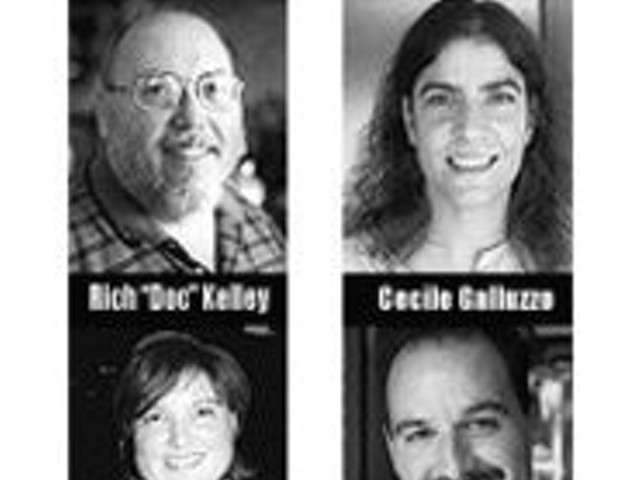A thinly veiled attempt: I recently read your article concerning STEP Inc. and its handling of a personnel matter [Geri L. Dreiling, "Ms. Step," Nov. 14]. I question your decision to refer to my criminal conviction for involuntary manslaughter in an article alleging misfeasance or malfeasance of the part of the STEP board. Your disjointed mention of a tragic 1998 auto accident -- which had absolutely nothing to do with any personnel actions taken by the STEP board -- is a thinly veiled attempt to slander the board by my previous association with it. This is a tactic I believe to be unworthy of a professional journalist or a newspaper that values its reputation for integrity.
It is not my purpose to enlighten you concerning the circumstances surrounding the personnel matter. Suffice it to say your recitation of what the STEP board did, did not do or was required or permitted to do pursuant to the published personnel policy of STEP bares faint resemblance to fact. The board of directors of STEP Inc. is and was composed of committed people who volunteer significant time and energy to an attempt to improve the circumstances of the poor in our community.
I was charged with a crime, asserted my innocence and went to trial -- not the board. The jury handed down my punishment. It was not a plea bargain or some type of backroom deal. If, as you imply, you disagree with their assessment of punishment, you substitute an opinion unencumbered by knowledge of the facts possessed by the jury. Likewise, this is what you have done in judging the board of STEP. In so doing you have done them a great disservice.
Richard G. Hughes
Florissant
Close it down: It's nice to finally see some attention drawn to this corrupt organization [where] I worked. Your article failed to mention the acquisition of a new office that sat vacant because the organization couldn't get their act together to move, costing the state thousands of dollars a month, or a phone system they "lost" and wound up paying a $75,000 bill on. And I won't even discuss the clients' driving up in their Mercedes-Benzes (yes, more than a few) with $200 hairdos, manicured nails, diamonds and designer clothes -- to pick up their free groceries and Dollar Help money. Your tax dollars at work, folks.
Many, many people were fired unjustly because they spoke up or perhaps noticed something corrupt. I urge Riverfront Times readers to write to Jefferson City and close this place down. Please don't print my name. I don't put STEP Inc. on my résumé, and I have no desire to ever be associated with this organization in any way.
Name withheld by request
Our Prized Pulitzer
Thanks for the memories: Thanks for the thorough recap of an important piece of St. Louis art-scene history [Eddie Silva, "Emmy Award," Dec. 5]. Emily Pulitzer, along with Sissy Thomas, Harriet Traurig and Patsy Degener, deserve many kudos for their efforts and passion in all things art. I've had the privilege to work with the last three women listed. I'll simply dream about one day getting caught in a stuck elevator with "Emmy" and enjoying an extended one-on-one chat about the beauty of minimalism. Thanks for the memories.
Barb Jordan
Maplewood
Right here, right now: Mrs. Emily Pulitzer -- her life, her loves, her contribution to the cultural life of St. Louis, her museum. Hurray Emmy! Thank you for being here in our time.
Fred Boeneker
St. Louis
Perpetuating a spatial disconnect: Far from being "the greatest work of architecture to go up in St. Louis" since the Wainwright Building, as Paul Goldberger described it, the Pulitzer Foundation for the Arts building by Tadao Ando treats its environment rather conventionally. It sits back from its property line and has its main entrance off of the sidewalk, accessible only from a large fenced parking lot that is glaringly visible from Washington Avenue. Its imprint on the streetscape is thus negative, as it makes no effort to interact with the social environment of its block. This building perpetuates a spatial disconnect from the street -- an import from suburban architecture that can be seen at its worst in the ongoing results of Mill Creek Valley destruction project. Ando's design fails to embody any of the qualities that beautiful, socially responsible urban architecture should. By the way, Eddie Silva's article claimed that the site of the building was a "vacant lot" before it was built. Actually, on that site stood the Beaumont Medical Building, which acknowledged its architectural and social context on that street rather well.
Michael R. Allen
St. Louis
Our Own Subversives
Tax-and-spend locals undermine our federal government: I agree that Maurice Gogarty is being unfairly punished [Ray Hartmann, "Barking Up the Wrong Tree," Dec. 5]. The problem is not the assessments but the resulting taxes that come from them. The Federal Reserve has cut interest rates and Bush has cut taxes to stimulate growth in the slumping economy. They are trying to put money in pockets of the public so they will spend it in places like the Delmar Loop. So what do our local politicians do? They raise taxes, thus negating what the feds are trying to do. That $300 to $600 dollars we received this year has been used to pay these outrageous property taxes instead of going to the local Target.
Brian Morley
University City





